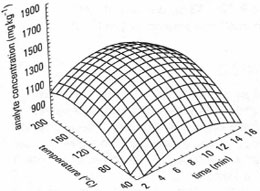Response surface methodology
Response surface methodology allows the relationship between the responses and variables to be quantified, using a mathematical model, and to be visualized. Thus the equation for a straight-line graph can be written as:| ⇒ Equation [43.2] | y = mx + c |
where m is a constant and c is the intercept. This describes the relationship between a single variable (x) and its response (y). Using the previous example, with three variables (x1, x2 and x3) it is possible to extend this mathematical model.
First of all we can consider how each of the variables influences the response (y) in a linear manner. However, the relationship between y and x1, x2 and x3 may not be linear, so it is necessary to consider the possibility of curvature. This is done in terms of a quadratic variable, i.e. a squared dependence (x12, x22 and x32). Finally, it is also important to consider the effects of possible interactions between the variables, x1 → x2 → x3, i.e. x1x2, x1x3 and x2x3. The overall general equation can therefore be written as:
| ⇒ Equation [43.3] | Y = b0 + b1x1 + b2x2 + b3x3 + b4x12 + b5x22 + b6x32 + b7x1x2 + b8x1x3 + b9x2x3 |
where b0 is the intercept parameter and b1 − b9 are the regression coefficients for linear, quadratic and interaction effects.
 |
| Fig. 43.5 Example of a response surface. |
In general, it is important to consider the following issues when carrying out an experimental design:
- Carry out repeat measurements for a particular combination of variables, to determine the repeatability of the approach.
- To remove systematic error (bias), you should randomize the order in which experiments are done.
- It is important to eliminate intervariable effects (confounding), i.e. the situation where one variable is inter-related to another.
- Often, the large number of experiments to be carried out makes it impossible to run all of them on the same day. If this happens run your experiments in discrete groups or 'blocks'.




